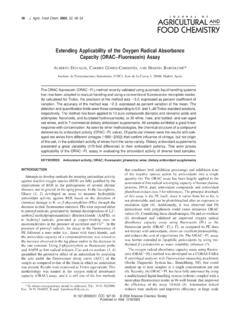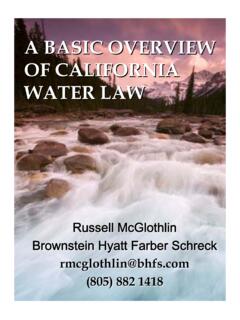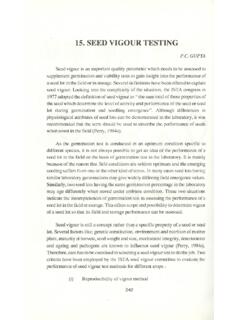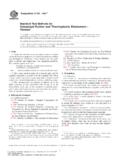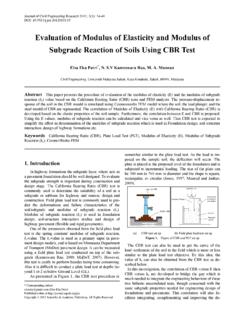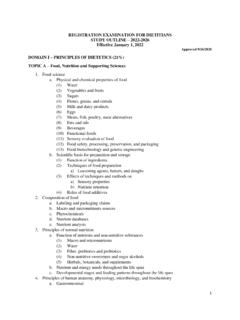Transcription of Test Methods for Color Measurement - UCANR
1 Copyright HunterLab 2006 Page 1 All Rights Reserved Insight on Color April, 2006, Vol. 18, No. 4 Test Methods for Color Measurement The world governing body for Color and appearance Measurement is the CIE, Commission Internationale de l'Eclairage, or the International Commission on Illumination. They can be found on-line at Their fundamental publication is Publication CIE 15:2004, Colorimetry, which provides detailed information on standard illuminants and observers, as well as the calculations for Color scales. The primary standards organizations for the colorimetric industry are: NIST, National Institute of Standards and Technology, NPL, National Physical Laboratory, NRC, National Research Council Canada, BAM, Bundesanstalt f r Materialforschung und -pr fung, In addition, many test Methods have been published by organizational bodies describing how Color Measurement should be performed in various industries.
2 Brief descriptions of some of them (primarily addressing instrumental as opposed to visual assessments) are provided below. This list is not intended to be exhaustive. AATCC Evaluation Procedures - Textiles American Association of Textile Chemists and Colorists (AATCC) evaluation procedures may be ordered through AATCC Evaluation Procedure 1, Gray Scale for Color Change, describes the use of a gray scale for visually assessing Color changes that occur during Color fastness tests . AATCC Evaluation Procedure 2, Gray Scale for Staining, describes the use of a gray scale for visually evaluating staining of adjacent fabrics during Color fastness tests .
3 AATCC Evaluation Procedure 6, Instrumental Color Measurement , is a reference document covering instrumental reflectance Measurement , transmittance Measurement , and related calculations. It also contains an appendix describing sample handling techniques. AATCC Evaluation Procedure 7, Instrumental Assessment of the Change in Color of a Test Specimen, describes how to instrumentally assess Color changes that occur during Color fastness tests . This procedure is intended as an alternative to Evaluation Procedure 1 s visual method. Applications Note April 2006 Vol.
4 18, No. 4 Copyright HunterLab 2006 Page 2 All Rights Reserved AATCC Test Methods - Textiles American Association of Textile Chemists and Colorists (AATCC) test Methods may be ordered through AATCC Test Method 110, Whiteness of Textiles, lists procedures for instrumentally measuring and calculating whiteness and tint of fabrics. AATCC Test Method 173, CMC: Calculation of Small Color Differences for Acceptability, describes how to calculate and use the dE CMC Color difference scale. AATCC Test Method 182, Relative Color Strength of Dyes in Solution, describes determination of Color strength of a dye spectrophotometrically by comparing its transmission measurements to those of a reference dye.
5 AS/NZS Australian/New Zealand Standards Australian Standard (AS)/New Zealand Standard (NZS) standards may be obtained through Standards Australia at AS/NZS , Colour Measurement with a Diff/0 Geometry Tristimulus Reflectometer, describes Color Measurement of non-fluorescent paper and board using a diffuse/0 colorimeter. AS/NZS , Paints and related materials Methods of test: Colour Principles of Color Measurement , provides an overview of colorimetric terms, illuminants, etc. AS/NZS , Paints and related materials Methods of test: Colour Methods of colour Measurement , describes the parameters of instrumental Measurement , including geometries and illuminants.
6 AS/NZS , Paints and related materials Methods of test: Colour Calculation of colour differences, describes calculation of Color differences using instrumental measurements. AS/NZS , Paints and related materials Methods of test: Colour Calculation of small colour differences using the CMC equation, describes the use of the CMC equations for Color tolerancing. AS , Methods of test for textiles Colourfastness tests Grey scale for assessing change in colour, adopts the ISO 105-A02 method described below for assessing gray scale during colorfastness testing.
7 AS , Methods of test for textiles Colourfastness tests Grey scale for assessing staining, adopts the ISO 105-A03 method described below for assessing staining of adjacent fabrics during colorfastness testing. AS , Methods of test for textiles Colourfastness tests Instrumental assessment of the degree of staining of adjacent fabrics, allows for gray stain values to be assigned using instrumental Color measurements. AS , Method of test for textiles Colourfastness tests Instrumental assessment of the change in colour for determination of grey scale rating, allows for gray scale values to be assigned using instrumental Color measurements.
8 AS/NZS , Textile floor coverings tests and measurements: Colourfastness tests Rubbing, describes how to evaluate visually or instrumentally the staining of cloths rubbed on floor coverings. Applications Note April 2006 Vol. 18, No. 4 Copyright HunterLab 2006 Page 3 All Rights Reserved AS/NZS 2633, Guide to the specification of colours, provides guidance on specifying colors, selecting a Color Measurement method, and establishing tolerances. AS , Methods of sampling and testing ceramic tiles Determination of small colour differences, provides a method for quantifying instrumentally Color differences between glazed ceramic tiles.
9 ASBC - Beer American Society of Brewing Chemists (ASBC) Methods may be ordered through ASBC Beer-10, Color , describes how to measure beer using a spectrophotometer and defines the ASBC Beer and Turbidity scales. ASTM Standard Specifications American Society for Testing and Materials (ASTM) standards may be ordered through ASTM C1510, Standard Test Method for Color and Color Difference of Whitewares by Abridged Spectrophotometry, describes how to measure reflectance and Color of ceramics using a sphere spectrophotometer. ASTM D156, Standard Test Method for Saybolt Color of Petroleum Products (Saybolt Chromometer Method), describes evaluating the Color of refined oils visually using Saybolt Color Units.
10 ASTM D985, Standard Test Method for Brightness of Pulp, Paper, and Paperboard (Directional Reflectance at 457 nm), describes how to determine brightness of white paper products (even those that include fluorescent whitening agents) using a 45 /0 instrument. ASTM D1003, Standard Test Method for Haze and Luminous Transmittance of Transparent Plastics, provides a procedure for the instrumental Measurement of luminous transmittance and haze of materials with haze values up to 30%. ASTM D1209, Standard Test Method for Color of Clear Liquids (Platinum-Cobalt Scale), describes visual evaluation of light, yellow-colored liquids using the PtCo (APHA) scale.
